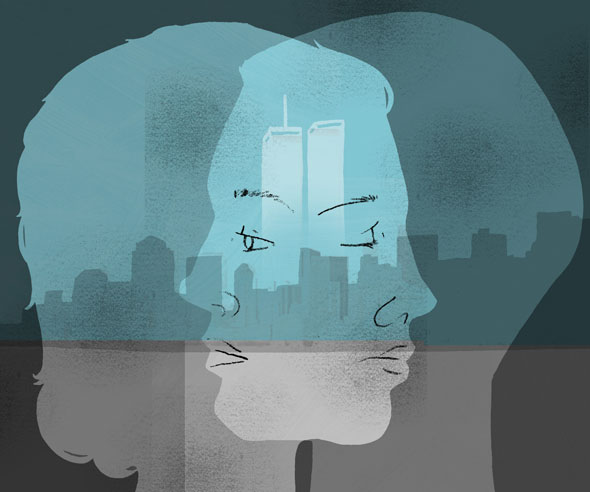social work
Treating a Mutual Trauma
A study examines how caregivers in disasters can function amidst their own distress
by Sally Lauckner / GSAS ’10
On September 11, 2001, Carol Tosone was sitting with a patient, David, in her Lower Manhattan office when they were startled by the whir and rattle of a low-flying plane. Just one mile from the World Trade Center, they soon heard the deafening impact of the jetliner crashing into the North Tower and the ensuing shrieks of horror and panic. In the weeks following, Tosone (SSSW ’93), an associate professor at the Silver School of Social Work, volunteered to help rescue workers, witnesses, and victims’ families deal with the trauma. In her private practice, she also helped patients process their individual 9/11 experiences.
But Tosone’s own distressing memories kept resurfacing, and sessions with David became particularly difficult. He was a trigger for that painful morning, and she found herself anxious and distracted during their conversations. It’s not unusual for therapists to have a visceral reaction to a patient’s story, otherwise known as “secondary trauma.” “People in my field are trained to handle that,” Tosone says. But after 9/11, she was experiencing something entirely different. She wondered: “What happens when you are going through the same trauma as your clients?”
Tosone embarked on a research project to help find an answer to that very question. She surveyed nearly 500 members of the National Association of Social Workers who lived and worked in Midtown and Lower Manhattan, and who were directly involved in helping 9/11 victims. More recently Tosone replicated the study in New Orleans following Hurricane Katrina. One of the biggest takeaways was the phenomenon of shared trauma. “You have experienced the trauma yourself in addition to working with others who are suffering from that same trauma,” explains Tosone, whose study revealed that, just like their patients, individual clinicians react differently to shared trauma.
Some reported a greater ability to empathize with their patients, while others were mentally and emotionally exhausted and suddenly found their jobs overwhelmingly difficult. Linda Mills, executive director of NYU’s Center on Violence and Recovery and a professor at the Silver School of Social Work, for example, was able to process her trauma from 9/11 in a useful way. Mills lives just blocks from Ground Zero and a piece of fuselage landed on the roof of her apartment building, displacing her family for several weeks after the incident. “My personal 9/11 experience allowed me to help others as a clinician [and became] the canvas for my own recovery and also for building my capacity to help others recover,” she says.
One thing that concerned almost all the clinicians involved in the studies was their lack of formal disaster training and uncertainty about how to help victims of trauma. “We need to rethink our approach to teaching about trauma in our [social work] schools,” Tosone says. “It is an elective at this point, and it needs to be infused throughout the curriculum.” Briana Barocas, director of research at the Center on Violence and Recovery echoes this. In 2008, she was part of a team, along with Mills, that published a Public Safety Trauma Response study examining the support programs available to NYC police officers, including 9/11 first responders. They also surveyed mental-health professionals who provided crisis support to those officers at Ground Zero and found results similar to those of Tosone. “A lot of the clinicians we spoke to were grappling with their own reactions to the event and their own prolonged exposure,” Barocas says. “We found that clinicians providing disaster support require additional training and ongoing peer support.”
Tosone next plans to conduct a study in Israel in order to compare how the three environments differ in impact—New York City was an acute, man-made attack; New Orleans is chronically exposed to natural disasters; and Israel is at constant risk for man-made terror. These elements are key in figuring out why certain clinicians thrive under specific conditions. The research is especially timely, Tosone says, given the rise in prominent natural disasters over the past few years, including major earthquakes in Haiti, Chile, New Zealand, and Japan, as well as violent tornadoes in the southern United States. “I want to figure out how the clinicians who were traumatized but still able to do their jobs managed it,” Tosone says. “We do know that the first thing clinicians need to do is help themselves. Unless they do, they can’t help others.”







